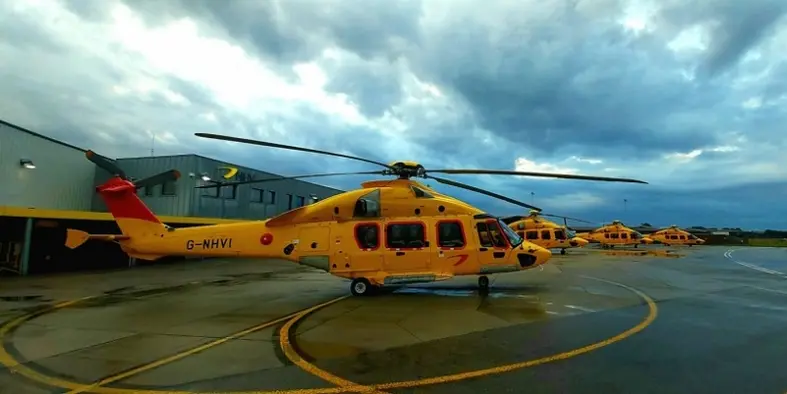

NHV Helicopters, a Belgium-based provider of helicopter services for the offshore industry, has been awarded a contract by Well-Safe Guardian on behalf of Repsol Sinopec Resources UK (RSRUK) to support well abandonment operations on the Buchan Field, central North Sea.
NHV specialises in B-to-B helicopter services and boasts a strong geographic presence in Europe and western Australia. For this contract in the North Sea, NHV will provide approximately four flights per week from the Aberdeen base to the Buchan Field to facilitate seamless connectivity to the project site. The company will utilise its H175 helicopters as it carries out the contract which is due to commence in mid-September 2023.
Jamie John, Commercial Director of North Sea Energy at NHV Group, remarked, “Securing this recent contract with Well-Safe Solutions will play a pivotal role in supporting the Buchan well abandonment operations. NHV has invested a lot into the energy industry and this contract is testament to our teams drive and level of service. Our top-tier fleet, including the advanced H175 model, coupled with our experienced crew, positions us well to meet the demands of this critical phase of operations.”
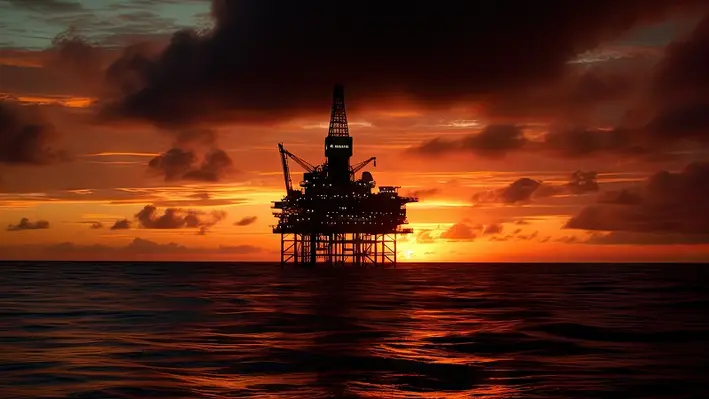

Silverwell Technology, a global provider of digitally intelligent gas lift production optimisation systems, has secured a contract with a major national oil company (NOC) in Southeast Asia.
The company will install its digital intelligent artificial lift (DIAL) production optimisation system across multiple oil wells across a three-year contract. The technology will be deployed in challenging operating environments in both brown and green field assets.
DIAL integrates in-well monitoring and control of gas lift well performance with surface analytics and automation in order to continually optimise gas-lifted fields, remotely and without intervention. Already utilised by operators around the world (both on and offshore), it is hoped that the successful completion of this contract will encourage more wide-spread adoption of DIAL by other operations in the region. In pursuit of this, Silverwell has expanded its local footprint by recruiting additional operations staff in Malaysia and Indonesia.
Badroel Rizwan Bahar, Regional General Manager Asia Pacific, surmised, “Our latest multi-well contract provides further evidence of the growing confidence among operators in DIAL’s ability to save them millions of dollars.”
Darrell Johnson, Silverwell CEO, added, “This milestone contract for the large-scale adoption of DIAL enhances Silverwell’s presence in an important geographic market. Around the world, sales of DIAL are increasing as operators seek proven methods to reduce operational expenditure while maximizing asset productivity.”
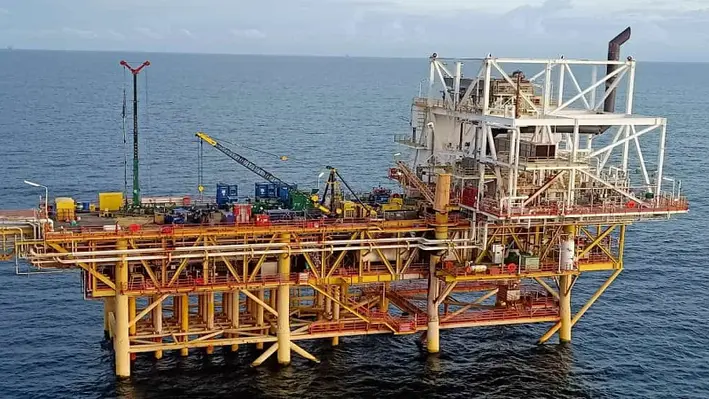

Thunder Cranes, an offshore crane rental and lifting solution provider, has provided a case study where it delivered lifting support for a standalone E-line well intervention offshore Malaysia.
The unnamed client requested Thunder Cranes assistance on an offshore platform as the existing crane had insufficient lifting capacity for loading and positioning the heaviest component of the E-line equipment from the supply boat to the platform main deck.
After accepting the challenge, Thunder Cranes provided a cost-effective lifting support solution in the form of a TC15 Stiff Leg crane which was deployed on the platform. In addition to lifting the components on deck, the Thunder Cranes crew also helped the well intervention team in skidding and repositioning the E-line equipment to multiple wellhead locations throughout the project.
Thunder Cranes reported that the operation was completed in a timely, safe and successful manner adding that, by deploying the TC15 Stiff Leg crane, the client benefitted from a cost-effective lifting solution that was well-suited to the platform size and need of the E-line contractor. It also avoided costly alternatives such as a lift vessel.
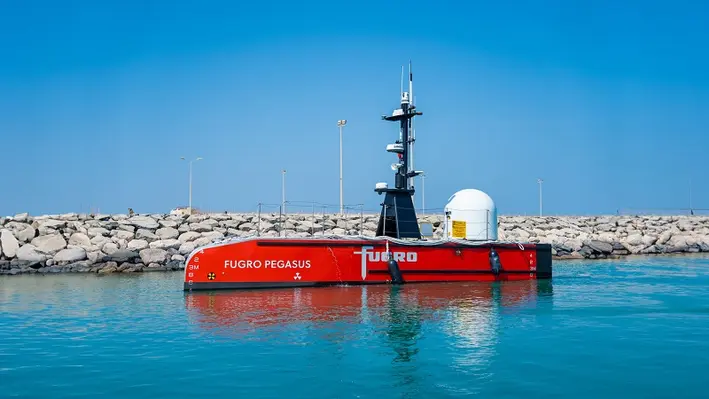

Fugro, a leading geo-data specialist and surveying services company, has completed the Middle East’s first remotely operated subsea inspection using a low-carbon emission unscrewed surface vessel (USV).
The company deployed the Fugro Pegasus USV (which is part of the Blue Essence fleet, built by SEA-KIT International) to perform site survey and inspection services on an offshore gas platform offshore UAE for operator Atlantis, ahead of its forthcoming decommissioning programme.
Fugro conducted the operation from its onshore remote operations centre (ROC) in Dubai, using a specialist team of mariners and surveyors to perform the subsea work on the UAQ3 platform within the Umm Al Quwain gas field. The Fugro Pegasus USV was equipped with a Blue Volta electric remotely operated vehicle which was used to inspect the integrity of the platform’s structure. It also generated a detailed map of the surrounding seabed.
All of this was streamlined to the ROC where it was reviewed in real-time during the operation. This data enabled the team to identify and investigate areas of further interest in the delivery of a comprehensive risk assessment for the client.
The economical design and optimised fuel systems of the company’s USVs eliminate 95% of carbon emissions against conventional vessels. This also allows them to remain at sea for up to two weeks without refuelling.
Patrick Boyce, Drilling Manager at Atlantis (UAQ), commented, “Fugro’s remote survey technology aligned seamlessly with our projects HSEQ, technical goals and was the most attractive commercial choice. The Fugro Pegasus was able to mobilise on time and despite difficult sea conditions, it completed the full scope of work in 40% of the allotted time frame. The USV operation was managed by the technical team at the very impressive Fugro ROC. Communications with the USV were strong throughout and provided excellent imaging results. Of particular note was the evident expertise and professionalism of the Fugro team, who have obviously dedicated many months to honing their execution procedures.”
Hannes Swiegers, Fugro’s Director of IRM Services & Remote Operations for the Middle East and India, surmised, “This is a significant milestone for our Middle East business and demonstrates how novel technologies can play a key part in delivering our clients’ long-term safety, sustainability and in-country value ambitions. Together with our clients, we are setting a new standard in geo-data acquisition and analysis through continuous innovation, reducing time, risk and carbon emissions. This new era of remote and autonomous technology will define the future of offshore operations in the energy sector and contribute towards a safer and more sustainable world.”
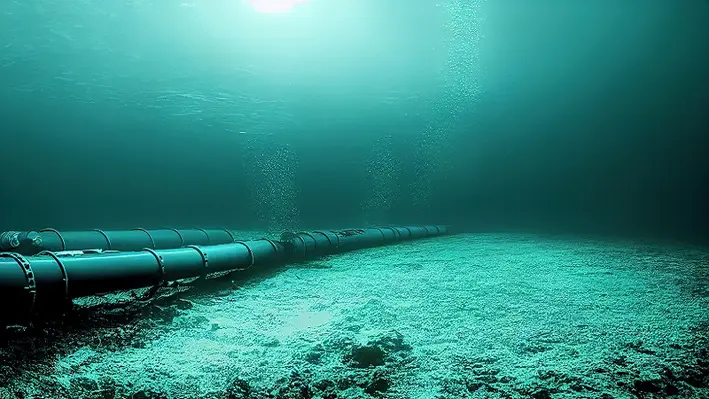

Perenco and Carbon Catalyst Limited (CCL) have been awarded a licence to progress the Poseidon carbon capture and storage (CCS) project following the conclusion of the first competitive carbon storage licence round of the North Sea Transition Authority (NTSA).
The project encompasses the Leman gas fields, one of the largest geological structures in the southern North Sea sector of the UK Continental Shelf (UKCS) and offers depleted gas reservoirs alongside saline aquifers to permanently store recovered CO2.
According to the companies, the project has the potential to significant decarbonise the East and Southeast of England when it comes online (expected 2029). Leman is connected via pipeline to the Bacton Terminal which will be utilised to receive and process CO2 from various onshore sources. This will then be sent to be injected offshore into reservoir rocks. Initial injection rates will be around 1.5mn tonnes per annum (Mtpa) and could ramp up to 40Mtpa across a 40-year period.
With the licence awarded, the project will now move into further detailed appraisal of storage sites with work commencing to bring the concept to delivery alongside mid-stream and up-stream partners.
Jo White, General Manager Perenco UK, remarked, “This is a fantastic opportunity to leverage Perenco UK’s deep experience of gas operations by developing a project that will help to support the UK’s energy transition, generate highly skilled jobs locally and nationally, and actively facilitate the government’s net-zero targets. We look forward to working with all stakeholders to deliver this strategic project.”
Henry Morris, Executive Director at Carbon Catalyst, added, “Poseidon has the potential to make a very material contribution to the decarbonisation of the UK economy by storing up to 40mn tonnes of CO2 per year into the giant depleted Leman gas field and overlying aquifer system. CCL is looking forward to supporting Perenco as they progress through the appraisal period towards final investment decision, with the ultimate goal of achieving first CO2 injection by 2029.”
Onwards with Orion
In addition to the Poseidon project, the partners have also announced that they have been awarded two further carbon storage licences to progress the Orion CCS project, designed to deliver an initial injection capacity of 1Mtpa.
The project encompasses the decommissioned Amethyst field as well as the West Sole field (currently producing). It will use depleted gas reservoirs for permanent storage. Injection is expected to commence in 2031 and could rise to 6Mtpa.
Perenco, which owns and operates significant gas infrastructure in the Humberside area will evaluate the possibility of reusing existing assets such as Dimlington Terminal for the project.
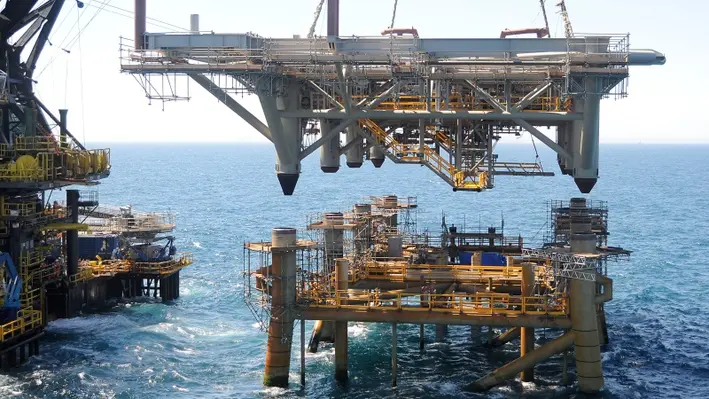
 The recent 'Decommissioning and Abandonment Australia 2023' conference held in Perth saw many insightful presentations from a distinguished list of speakers. On the legal and regulatory side, Ben Adamson, a lawyer from HFW, an international law firm specialising in offshore energy and maritime law, provided a diverse audience with an in-depth dive into Australia’s offshore decommissioning regime.
The recent 'Decommissioning and Abandonment Australia 2023' conference held in Perth saw many insightful presentations from a distinguished list of speakers. On the legal and regulatory side, Ben Adamson, a lawyer from HFW, an international law firm specialising in offshore energy and maritime law, provided a diverse audience with an in-depth dive into Australia’s offshore decommissioning regime.
Ben kicked off his presentation with a briefing on the international framework relevant to decommissioning, which is driven primarily by United Nations Convention of Law of the Sea (UNCLOS) and the International Maritime Organisation (IMO). He then transitioned his presentation to discuss Australian legislation designed to enforce local decommissioning obligations. Of particular interest were his comments comparing and contrasting various national regulatory regimes, which appear to vary significantly between countries and offshore regions.
Ben pointed out that nothing in the Australian offshore oil and gas industry happens in a vacuum. An overlay of international laws and conventions exists that will continue to have a real effect on how Australia regulates the large pipeline of decommissioning work set to take place over the next two decades.
Revamped regime
The most important parts of the Australian offshore decommissioning regime are set out in the Offshore Petroleum and Greenhouse Gas Storage Act 2006 and its various regulations. Parts of the Act relevant to decommissioning underwent a major overhaul in 2021 to make the legislation fit for purpose and to respond, in part, to an unfortunate series of events where the decommissioning of an Australian FPSO and associated offshore field fell at great cost to the Australian taxpayer following the insolvency of the titleholder.
As Ben set out, the Australian government appears anxious to avoid a repeat of such events. The central pillar of the revamped Australian decommissioning regime is that titleholders must maintain and repair all structures, equipment and property brought into a field. Once the structure, equipment or property is no longer in use, titleholders must remove it. If the current titleholder is not available, or is unable or unwilling to undertake decommissioning, the Australian government has the power to bring former titleholders (as well as a range of other parties) back to decommission the offshore asset.
Trailing liability
The most important and topical of the changes to Australia's offshore decommissioning regime is what Ben described as trailing liability. Common in some other offshore jurisdictions around the world, trailing liability means that the government has the power, as a last resort, to 'call back' a past titleholder to remediate the environment or remove property. In that context, Ben raised some pertinent questions such as what would or could occur if at some distant point in the future a plugged well began leaking oil. Who will (or should) be brought back under a trailing liability regime to remediate it? Is it fair to force a former titleholder to decommission a well where that titleholder was at some point operating the field, but was otherwise not responsible for drilling or plugging the well?
In addition, Ben canvassed a number of other as-yet unresolved aspects of Australia's new decommissioning laws that arise from trailing liability. For example, what is the fair approach regarding small-percentage titleholders that form part of a joint venture comprising the titleholder? In the event that a former titleholder must decommission an asset, should they be entitled to tax breaks? Further, as Ben put it, can titleholders ever get a 'clean break' from a field after legitimately divesting their interest, if the spectre of trailing liability exists in perpetuity? As Ben concluded, current Australian decommissioning laws do not fully address these tricky issues, as well as a host of other issues raised by the new regime.
The second important point under the new Australian framework is that surrender of titles can only occur with the consent of the regulator. If a titleholder has not done the necessary decommissioning and the field is nearing the end of its life, Ben pointed out that with the passage of the amendments to the legislation, it will be difficult for the titleholder to transfer title, especially to a more speculative entity attempting to extract profit from an aging field.
In light of the major overhaul to Australia's decommissioning laws, Ben's opinion was that the most interesting aspect of Australia's updated decommissioning regime is how the regulator will manage its growing regulatory burden while upholding Australia's decommissioning obligations under international law. This is a complex and involved area that will evolve over time.
Increased accountability from titleholders
In terms of the role the Australian oil and gas regulator plays, the revamped decommissioning regime hands the regulator a new arsenal of powers to enforce titleholders' decommissioning obligations. Broad powers now exist to monitor and if necessary, intervene to stop, changes to the control of a titleholder, and passage of title from one titleholder to another.
Now, a change of ownership at the level of the titleholder is firmly within the regulator's grasp. Ben stated that players in the market can expect the regulator to act should it conclude, for example, that the entities taking control of a titleholder are not suitably resourced or experienced, or do not have the appropriate financial backing to carry out decommissioning. Before concluding his remarks about the new Australian regime, Ben reiterated that the trailing liability laws and powers to intervene in changes to control of the titleholder do not directly apply to contractors, employees, banks or customers.
The second part of Ben's presentation was a practical discussion on what a typical decommissioning contract may look like from a risk management perspective. He prefaced the discussion by setting out the typical options presented to those engaged in work offshore: either transfer risk, or accept it, insure against it, and price it in. Although decommissioning is a highly specialised undertaking, in Ben's view, the major themes and principles underlying contracts typically found in the offshore oil and gas sector would be relevant for offshore decommissioning contracts.
The offshore industry is a unique environment and there have been, over a long period of time, contractual terms developed that deal with the unique risk and liability issues faced in the offshore setting. Ben was clear that the typical knock-for-knock indemnity arrangements so common in the wider offshore and maritime world would likely be retained in decommissioning contracts, because these terms allowed contracting parties to either transfer risk, or assume it and insure against it.
Dealing with waste
Perhaps the biggest difference between typical offshore contracts and decommissioning contracts is how waste is dealt with. This aspect of Ben's presentation was directed to those in the audience who are preparing to deal with the vast volume of waste equipment, assets and material that is expected to be generated over the coming decades as Australia tackles its offshore decommissioning task. The big questions in this space are: what is to be done with the waste (some of it clearly hazardous) and crucially, how risk and title in the waste may be transferred between contracting parties. Ben recounted the difficulty his clients experienced exporting Australian offshore oil and gas waste overseas. As a final parting word, he challenged those present to develop local, home-grown waste disposal alternatives to avoid the issues arising in sending Australia's hazardous waste overseas.
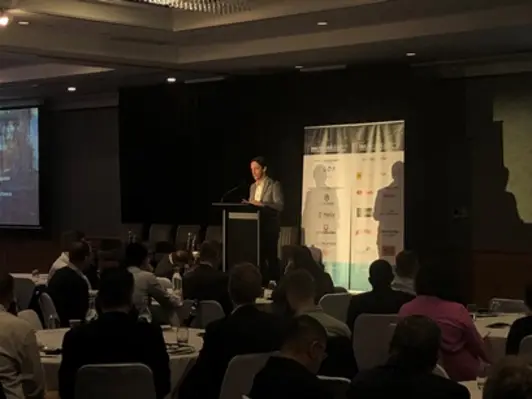

 Archer has been awarded a US$165mn decommissioning contract by Repsol Sinopec Resources UK Ltd. for the execution of plug and abandonment (P&A) services in the Fulmar and Halley Fields in the North Sea.
Archer has been awarded a US$165mn decommissioning contract by Repsol Sinopec Resources UK Ltd. for the execution of plug and abandonment (P&A) services in the Fulmar and Halley Fields in the North Sea.
The awarded contract is for a fully integrated P&A project, covering the complete work scope and services of the 30 Fulmar Field wells and the two Halley Field wells.
The Fulmar scope includes the removal of the existing drilling facility and the installation of Archer’s P&A rigs, as well as its full P&A well services offering to reduce time and cost. The work will be carried out using leading digital solutions in collaboration with the company’s partners, and operations are expected to commence in H2 2024.
Dag Skindlo, CEO of Archer, said, “We are delighted that Repsol Sinopec has elected Archer and our fully integrated operational model for this P&A project. The delivery model with integrated drilling and well services, supported by partners, is a step change in how operators permanently plug and abandon oil and gas wells. Archer has worked strategically over several years to develop this fully integrated model and we are excited that Repsol Sinopec has chosen Archer as its partner.
“The permanent plugging and abandonment of oil and gas wells is an essential activity as the world decarbonises on the road to net-zero. Our goal is to industrialise the P&A process and spearhead innovation to cut operators’ P&A costs globally.”
Adam Sheikh, Repsol Sinopec’s VP of Decommissioning and Energy Transition, commented, “We aim to deliver one of the North Sea’s most ambitious decommissioning programmes in the years ahead – including the full decommissioning of our Fulmar Alpha Asset. This contract award represents a significant milestone in our decommissioning journey and my thanks go to the teams for the vast amount of work to get us to this stage. We look forward to working closely with our partner Archer to safely deliver this decommissioning scope of works on our Fulmar Alpha facility."
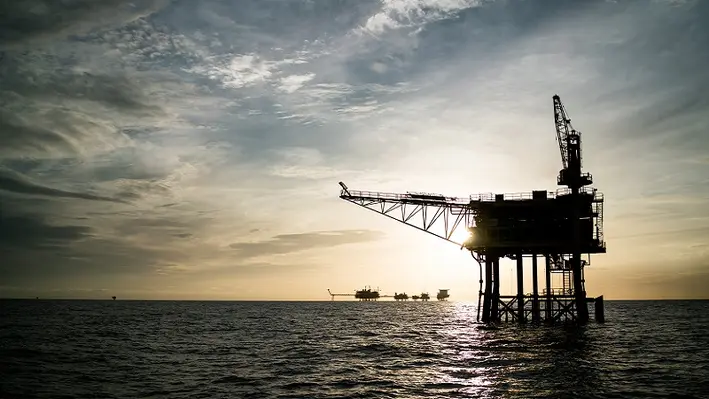

According to new research by the North Sea Transition Authority (NSTA), the oil and gas industry in the North Sea spent UK£1.6bn on decommissioning redundant wells and infrastructure last year.
This figure is more than any in the previous five years with UK£8bn spent accumulatively between 2017 and 2022 and will remain high for the years ahead, with UK£2bn expected to be spent per year in the next decade. Of the work associated with the UK North Sea alone, UK suppliers are forecast to take the lion’s share at 70%.
The NSTA was pleased to indicate that the sector appears to be living up to its North Sea Transition Deal Pledge to ensure at least half of decommissioning spending goes to the UK supply chain and that it is meeting legal obligations to clean and remove infrastructure once production ceases. It continued that the industry has now built an impressive track record of carrying out decommissioning projects cost-efficiently and safely due to its willingness to share learnings and date. It is also embracing new technologies' commercial models.
Emerging challenges in recent years – such as a heightening demand for equipment, vessels and services from other regions and sectors – has led to an estimated total decommissioning cost of around UK£40bn that must be footed in the years ahead. However, the NSTA has stated it is confident the industry can overcome associated hurdles, meet cost-efficiency targets and ultimately lower the estimate to around UK£33.3bn by the end of 2028.
To support this, the NSTA is providing ongoing support by introducing new key performance indicators and benchmarks to provide a more complete picture of how well decommissioning projects are being planned and executed. This will help to identify opportunities for industry stakeholders to improve performance and realise further cost-efficiencies.
Pauline Innes, NSTA Director of Supply Chain and Decommissioning, remarked, “The North Sea decommissioning sector is highly active and productive, and the industry is ideally placed to realise the massive UK£21bn opportunity which will come its way over the next 10 years.
“However, operators must redouble their commitment to collaborate with the supply chain and plan even more effectively if they are to overcome challenging market conditions and remain competitive on cost. The NSTA will continue to use its powers and influence to support the industry as it strives for continuous improvement, including through the development of new benchmarks.”
Bob Fennell, DaRT Co-Chair and North Sea Executive Vice President at Harbour Energy, added, “It is critical that North Sea operators work together to ensure that oil and gas assets which, at the end of their production life, cannot be repurposed to support new technologies like carbon capture and storage, are decommissioned safely and in the most cost-effective manner. Collaborating and sharing data is an important first step to providing the supply chain with the visibility and confidence they require to meet UK demand for such works in a timely and cost-competitive way.”
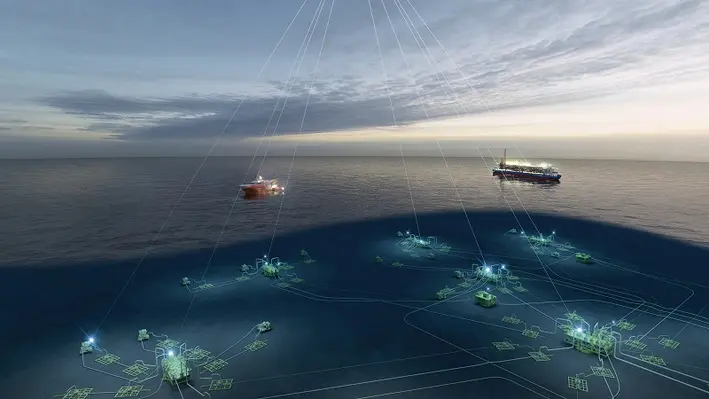

The proposed joint venture between SLB, Subsea7 and Aker Solutions has taken the next step to being realised following regulatory approval by antitrust authorities in Brazil.
With the signing off from the Brazilian authorities, all regulatory approvals and clearances have now been obtained, including those required in Angola, Mozambique, Australia, Norway and US, making the Q4 2023 closing more likely.
The joint venture has been pursued in order to help customers unlock reserves, reduce time to first oil, lower development costs and achieve decarbonisation goals in their projects. The companies will pool their deep reservoir domain and engineering expertise, extensive subsea production and processing technology portfolios, manufacturing scale and capabilities, and comprehensive suite of life-of-field solutions for clients around the world. This has this been described as a “milestone in subsea production economics” by the companies.
Following this announcement, the parties have stated they will continue to work to satisfy the remaining conditions for closing and aim to do so as practicably possible in Q4 2023.
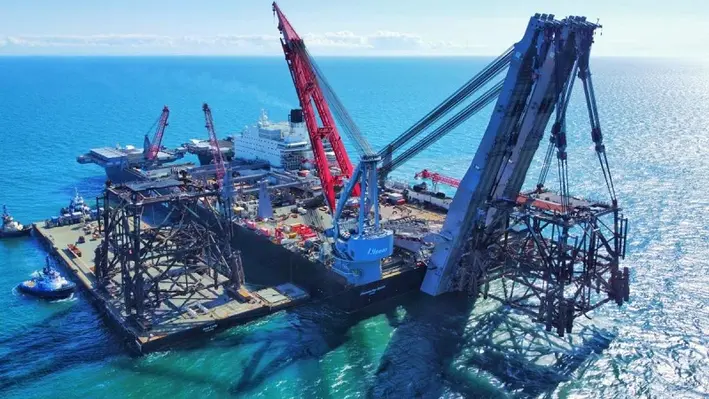

Spirit Energy is celebrating its busiest-year-to-date in regards to decommissioning activities across the Central North Sea (CNS), Southern North Sea (SNS) and East Irish Sea.
Some of the recent work to complete includes the final phase of the campaign to remove the DP3 and DP4 installations in the Morecambe Bay development. Allseas completed the work through the use of Pioneering Spirit, the largest and most versatile offshore construction vessel in the world which is capable of lifting entire topsides of up to 48,000 t and jackets up to 20,000 t in a single piece. For this project in the East Irish Sea, a total of 9,000 t of jacket structures were removed in tandem using the jacket lift system and loaded directly onto the Iron lady. It was then to be transferred to Fife for recycling.
In CNS, a 14 well plug and abandonment campaign is being executed from the Well-Safe Defender vessel across four fields: Chestnut, Birch, Larch and Sycamore. Chestnnut’s decommissioning has now been completed.
“The Chestnut campaign has been delivered with exemplary safety and operational performance; this was our ultimate aim when we set out to select our partners for the CNS abandonment campaign. With this first milestone achieved we look forward to the remainder of the campaign,” remarked Nicholas Riley, Well Operations Manager, Spirit Energy.
Meanwhile, in SNS, Heerema Marine Contractors has successfully removed three topsides and three jackets with SSCV Thialf crane vessel. DeepOcean are set to recover subsea infrastructure from six assets later this year. The recycling of the all the structures will be conducted by Thompsons of Prudhoe in the Port of Blyth.
Head of Decommissioning and projects at Spirit Energy, Donald Martin, commented, “Combining decommissioning programmes and supply chain opportunities at portfolio level has created significant economies of scale with our partners leveraging the capability of their assets. This has also helped create opportunities to share campaign management responsibilities, leading to a lean and agile team. The recent successful completion of the removals of the DP3 and DP4 jackets marks a significant milestone towards our longer-term transition plan for the Morecambe hub being converted into a world-class carbon storage cluster.”
Spirit Energy, CEO, Neil McCulloch, concluded, “We are very proud of our efforts and achievements in decommissioning carried out by a first-class team of Spirit employees working collaboratively with the supply chain. Our team has thought strategically and formed long-term, high-value and high-trust relationships with our supply chain partners and we are very pleased to have achieved such a high level of local content and repeat business with UK and Netherlands based firms where our core business lies. Of course, we are also pleased to continually deliver industry leading decommissioning cost performance in line with our stewardship obligations from our regulators.”


The global offshore well intervention market is set for a period of extended growth in light of stable oil prices forecast in the short-term, maintained oil demand in the medium- and possibly long-term, and ever-increasing environmental pressures.
Globally, spending on well intervention is on the rise with Rystad Energy predicting an increase by almost 20% in 2023 to take the total tally to US$58bn. This is just the start of a forthcoming surge with 17% of wells predicted to go through the intervention process by 2027.
North America accounts for 64% of the total wells ready for intervention by 2027, according to Rystad, giving rise to the dramatic potential of the market in the Gulf of Mexico. According to BSEE, there are approximately 1,885 active production platforms on the OCS with more than 60% older than 25 years.
This is leaving operators grappling with the need to maintain production rates while also dealing with ever-ageing infrastructure, with mounting regulatory pressure increasing the need to address decommissioning obligations. In facing this conundrum, an increasing amount of well intervention activity is highlighting the importance of this service as a means to address both sides.
As new technological innovations become more viable and the understanding around methods such as light well intervention build, the market will only advance in stature, suggesting it will finally meet the potential it has promised for so long, creating a tantalising future for the crowd of service and equipment providers offering their assistance.
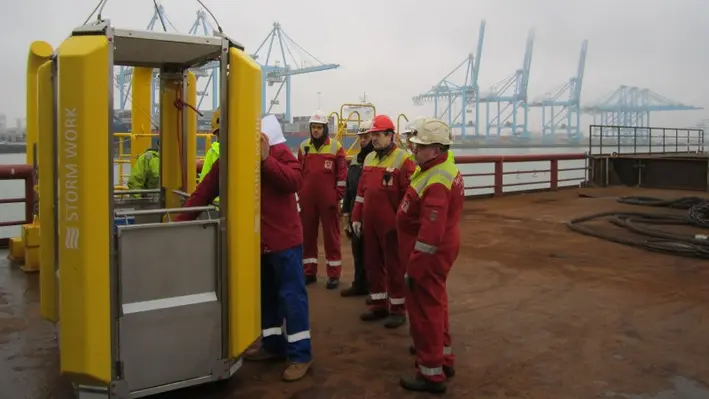
 Reflex Marine's STORM-WORK suspended work basket was successfully employed in its 100th offshore project in October 2020.
Reflex Marine's STORM-WORK suspended work basket was successfully employed in its 100th offshore project in October 2020.
The STORM-WORK was designed specifically for offshore industrial work activities and was very well received by offshore operators across industries – heavylift, decommissioning, oil & gas, and offshore wind. ConocoPhillips in Australia is using the customised enlarged version of STORMWORK while the standard units have been employed in multiple projects throughout Europe, among others, with Seaway7.
The design, safeguarding both the workers inside the basket and the assets worked on thanks to the soft-touch features and contoured shape, is praised by users worldwide. The small footprint and light weight allow for improved manoeuvring, while the highly durable, low-maintenance materials used ensure long unit lifespan.
“The unit is excellent for accessing areas with obstacles and tight landing spaces," comments a STORM-WORK user from Boskalis. Reflex Marine’s innovative work basket design has been recognised by industrial engineering body LEEA with an award in the Safety category confirming the outstanding crew protection features and safety benefits.
STORM-WORK is available for purchase and hire and can be customised to meet the required size and capacity.
Page 59 of 111